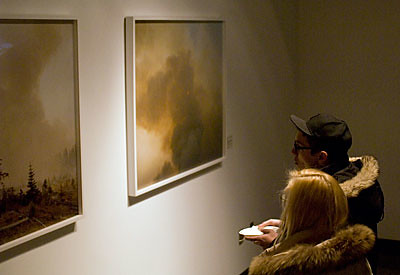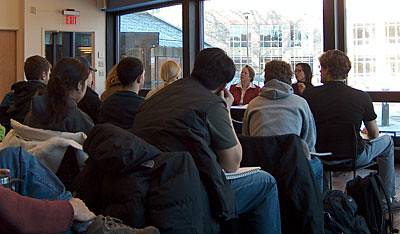![]() The Colgate community on Thursday took part in a nationwide discussion about global warming.
The Colgate community on Thursday took part in a nationwide discussion about global warming.
Nearly 20 discussions, workshops, and film screenings were held as part of Focus the Nation, a teach-in focused on finding solutions to global warming and to raising the issue’s political profile.
The campuswide effort, organized by a team of 30 students and faculty members, resulted in a jam-packed schedule of events that adds to the university’s exploration of environmental issues.
Here is a look at some of the day’s sessions:
Search for sensible solutions can be difficult, panelists say
— By Anthony Adornato
Despite all the hype about turning corn into ethanol, the concept isn’t as environmentally-friendly as you might believe.
That was Gavin Leighton’s ’09 message to 30 students and faculty inside Golden Auditorium.
Leighton, who helped organize events for the university’s Focus the Nation, spoke passionately about the need for alternative forms of energy, but he said “using corn for fuel doesn’t help at all when it comes to combating global warming.”
Leighton presented the audience with research that indicates ethanol actually takes more energy to create than it produces because of such factors as the amount of fuel necessary for machinery to process the crop.
“There’s no magic bullet to solving our environmental problems,” said Robert Turner, professor of economics and environmental studies.
Instead, Turner offered recommendations that the Colgate community can take to reduce its carbon footprint.
“We need to be more mindful in our every day lives; monitor how much you drive, use less heat in your home by turning down the thermostat and making sure your house is properly insulated, and don’t hesitate to let politicians know the importance of environmental issues.”
Lyle Roelofs, provost and dean of the faculty, said Colgate takes environmental sustainability seriously.
Roelofs outlined efforts by the university to implement “green” practices, including a special computer-based system that tracks energy use at different locations around campus at any give time.
Other examples include usage of organic fertilizer, expanded use of recycled papers and shuttle buses equipped with EPA-approved low-emission diesel engines.
“Combating global warming is a team effort and this forum shows how Colgate can take the lead,” said Roelofs.
 |
| Colgate students Charlotte Howells ’10 and Dan Frank ’10 inspect photographs that are part of The Canary Project exhibition. (Photo by Luke Connelly ’09) |
Canary Project uses photographs as a call to action
— By Brittany Messenger ’10
Just as canaries were used by miners to warn of deadly methane levels, The Canary Project serves to warn people of the “severe changes to come” due to global warming.
Susannah Sayler and Edward Morris presented their work, which uses photography to communicate the urgent need for action against human-induced climate change, in Golden Auditorium.
These striking images of melting glaciers in Austria, “drunken” forests in Alaska, river erosion in Bangladesh, and forest fires in eastern Washington are meant to both entice and shock the audience with the worldwide visible affects of global warming.
“We really wanted to show the diversity of the effects,” explained Sayler. “It’s hard to pick out what all is going to happen, so we came up with the categories we wanted to illustrate–melting glacial ice cap, rising sea level, extreme weather events, and drought fires.”
Morris and Sayler rely on the access of communication to spread the word about their “political art.”
“Art has the capacity to penetrate received notions, generate media attention and create lasting visceral impact — all of which can be a more effective catalyst to action than mere rational apprehension,” they explain.
Cary Peppermint, professor of art and art history, appreciated Morris and Sayler’s combination of arts and activism.
“The best thing I think an artist can do is interrupt somebody’s day — to cause a pause or have a moment of reflection,” Peppermint said. “When students come through this exhibition space, it interrupts their day by seeing these images that are violent, though they are aesthetically very pleasing.”
Here is more information about The Canary Project.
Panel dispenses environmentally conscious tips for homeowners
— By Aleta Mayne
Home builders Norm Von Wettberg ’69 and Peter Darby joined Jim Bona ’75 to address the question “What can homeowners do?” to lessen their environmental impact.
The session was not only valuable for Hamilton homeowners in the audience, but students should also be more conscious of choices they make in their living spaces, according to Bona, who is instructional technology coordinator at Colgate.
Von Wettberg added to that sentiment, saying, “If we’re going to have an effect on global warming that’s going to make a difference for the students and their children and grandchildren, everybody has to think about all of their actions and what impact their actions have, from the smallest to the largest.”
The panel offered the following conservation tips, from small steps to large:
• Don’t let faucets run unnecessarily
• Turn off lights when leaving a room
• Educate yourself about what is recyclable in your area and recycle
• Eliminate synthetic cleaners and use alternatives such as lemon juice and ammonia
• Turn off electronics when they’re not being used
• Compost vegetable and fruit waste
• Change regular lightbulbs to compact florescent lightbulbs
• Downsize: “It doesn’t matter whether it’s the size of your refrigerator, the size of your house, the size of your car… We need to downsize to the size that is needed, not the size that competes with the person across the street,” said Von Wettberg.
• Hire a contractor to work with you toward improving your home’s energy efficiency (e.g., added insulation, replacing substandard windows)
The panel concluded that while some conservation choices may incur additional costs at first, they will be well worth it in the future.
 |
| Associate professor of religion Eliza Kent (front left) and assistant economics professor Cheryl Long speak to students about global warming and developing nations during one of nearly 20 sessions held as part of Focus the Nation. |
Utilizing locallly grown foods is worth the effort, panelists say
— By Barbara Brooks
Finding locally grown produce is especially challenging during winter in central New York; however, according to five panelists and moderator Stephanie Tubman ’08, there are plenty of good reasons for making the effort. There also are obstacles.
“With fossil fuels, fertilizer, pesticides, and tractors, the goal of agriculture has become efficiency,” said Kate Reynolds, of the Colgate Bookstore. “Grow lots of food as cheaply as possible and move it anywhere.”
But, Reynolds said, using local sustainable food is better for the soil, sustains biodiversity, requires no fossil fuels, and is generally fresher and tastier than food grown on centralized farms and trucked across the country.
Rachel Surprenant ’08 added that it’s also better for the local economy, and better for students’ health. Will Kershman ’11 stressed that using local food helps build relationships in the community.
Sam Stradling, a local resident and volunteer for the Hamilton Food Cupboard, spoke firsthand about the satisfaction in distributing fresh fruit and vegetables to local families, thanks to support from a grant from Colgate’s Upstate Institute.
At Colgate, a growing group of students, faculty, and staff would like to see more local foods served on campus.
Practical matters fall to George Murray, director of Colgate’s dining services, who said he purchases local products whenever possible, including regional produce from a Syracuse distributor, and dairy products from the Crowley Dairy Co.
He also regularly meets with area food service professionals to collaborate on ways to support sustainability.
“But there are definite roadblocks,” Murray said, citing transportation, seasonal availability, and food safety. Communication also is an issue.
“We are trying to do a better job of marketing our local products in Frank, so people will know what they are getting,” he said.